University of Madras
The University of Madras or Madras University is a public state university in Chennai, Tamil Nadu, India.[2] Established in 1857, it is one of the oldest universities in India, incorporated by an Act of Legislative Council of India under the British government.[3]
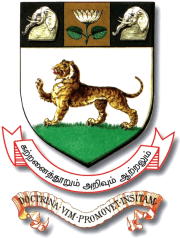 | |
| Motto | Doctrina Vim Promovet Insitam (Latin) |
|---|---|
Motto in English | "Learning Promotes Natural Talent" |
| Type | State university |
| Established | 1857 |
| Chancellor | Governor of Tamil Nadu |
| Vice-Chancellor | Dr. P. Duraisamy |
Academic staff | 345[1] |
| Students | 4,819[1] |
| Postgraduates | 3,239[1] |
| 1,099[1] | |
| Location | , , 13°5′2″N 80°16′12″E |
| Campus | Urban |
| Colors | Cardinal |
| Affiliations | UGC, NAAC, AIU |
| Mascot | Lion |
| Website | unom |
It is a collegiate research university and has six campuses in the city: Chepauk, Marina, Guindy, Taramani, Maduravoyal and Chetpet. It offers more than 230 courses under 87 academic departments of post-graduate teaching and research grouped under 18 schools, covering diverse areas such as sciences, social sciences, humanities, management and medicine along with 121 affiliated colleges and 53 approved research institutions. The university houses the national centres for nanotechnology,[4] photonics[5] and neurotoxicity research.[6] Besides, having three Centres of Advanced Study (CAS) in biophysics,[7] botany[8] and mathematics.[9]
The National Assessment and Accreditation Council has conferred 'five star' accreditation to the university in the first cycle, and subsequently with its highest 'A' grade.[10] The University of Madras has been given the status of 'University with Potential for Excellence (UPE)' by the University Grants Commission.[11] Madras University is also recognized among the 12 universities in India having the 'Centre with Potential for Excellence in Particular Area (CPEPA)' with a focus on drug development and climate change.[12]
University of Madras is the alma mater of two Indian Physics Nobel Laureates, CV Raman and Subrahmanyan Chandrasekhar, five Presidents of India, including A.P.J. Abdul Kalam, and several notable mathematicians including Srinivasa Ramanujan.
History
| Vice-Chancellors[13] |
|---|
|

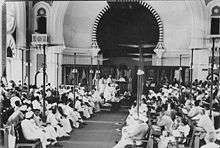
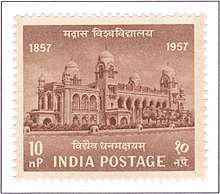
The first ever demand for higher education in Madras Presidency was given in a public address to Lord John Elphinstone, Governor of Madras, signed by 70,000 residents when the Governor in Council was contemplating "some effective and liberal measures for the establishment of an improved system of national education." This public petition, which was presented by the Advocate General Mr. George Norton on 11 November 1839, pressed the need for an English college in the city of Madras. Pursuant to this, Lord Elphinstone evolved a plan for the establishment of a central collegiate institution or a ‘university.’ This university had twin departments – a high school for the cultivation of English literature, regional language, philosophy and science, and a college for instruction in the higher branches of literature, philosophy and science.
The University Board was constituted in January 1840 with Mr. George Norton as its president. This was the precursor of the present Presidency College, Chennai. A systematic educational policy for India was formulated 14 years later by Wood's despatch, which pointed out the rationale for "creating a properly articulated system of education from the primary school to the University." The Dispatch recommended the establishment in the universities of Professorships "for the purposes of the delivery of lectures in various branches of learning including vernacular as well as classical languages." As a result, the University of Madras, organised on the model of the University of London, was incorporated on 5 September 1857 by an Act of the Legislative Council of India.
The university progressed and expanded through the 19th century to span the whole of South India, giving birth to universities like Mysore University (1916), Osmania University (1918), Andhra University (1926), Annamalai University (1929), Travancore University (1937) presently University of Kerala, Sri Venkateswara University (1954), Madurai Kamaraj University (1966), Tamil Nadu Agricultural University (1971), Anna University (1978), Tamil University (1981), Bharathidasan University (1982), Bharathiar University (1982), Mother Teresa Women's University (1984), Alagappa University (1985), Dr. M.G.R. Medical University (1989), Veterinary and Animal Sciences University (1989), Manonmaniam Sundaranar University (1990), Periyar University (1997), Dr. Ambedkar Law University (1996) and Thiruvalluvar University (2002).
In 1912 endowments were made to the university to establish departments of Indian History, Archaeology, Comparative Philology and Indian Economics. In that year the university had 17 departments, 30 teachers, and 69 research scholars. Later the research and teaching functions of the university were encouraged by the Sadler Commission and the gains of the university were consolidated by the enactment of the Madras University Act of 1923. About this time, the territorial ambit of the Madras University encompassed from Berhampur of Odisha in the North East, Trivandrum of Kerala in the South West, Bangalore and Mangalore of Karnataka in the West and Hyderabad of Andhra Pradesh in the North.
Between 1926 and 1939, the university published the comprehensive Tamil Lexicon dictionary, which is the first among the dictionaries published in any Indian language.[15]
Coat of arms
The description of the Coat of Arms of the university, designed in 1857, is:
"Argent (silver or white) on a Mount issuant from the basement a Tiger passant proper (walking and coloured naturally), on a Chief Sable (black across the top), a Pale Or (a gold or yellow vertical strip down the centre 1/3 of the top or chief), thereon, between two Elephants heads couped of the field, a lotus flower leaved and slipped of the third, together with this motto Doctrina Vim Promovet Insitam".
The coat of arms colours are: the base is light green, the tiger is yellow on a white background, the elephant is grey on a black background, the lotus is a white flower with olive green leaves, on a gold background. The motto scroll is edged red, with black lettering. The English translation of the motto of the University of Madras is: "Learning promotes natural talent."
Senate House
The University of Madras has a historical monument – Senate House – which is one of the landmarks of the city of Chennai. The Senate House, the university's first building, inaugurated in the year 1879, is a masterpiece of Robert Fellowes Chisholm, an architect of the 19th century, who blended the Indo-Saracenic style with Byzantine and European architectural features. The university renovated the Senate House in 2006.
Campuses and constituent colleges
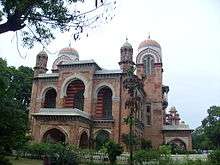
The university is spread over six campuses, namely, Chepauk, Marina, Guindy, Taramani, Chetpet and Maduravoyal. The Chepauk campus of the university houses the administrative buildings, the historic Senate House, central library, clock tower, centenary auditorium, and several departments under arts, humanities and social science streams. The schools of oriental and Indian are located in the Marina campus. The Guindy campus incorporates the natural sciences departments while the campus at Taramani houses the school of basic medical sciences. The sports union and the botanical garden are based in Chetpet and Maduravoyal campus respectively. The Department of Mathematics of the university is operated as the Ramanujan Institute for Advanced Study in Mathematics located close to the Chepauk campus.[16] The university has two constituent college, in Nemmeli and Thiruvottiyur, offerings courses in arts and science.[17] Since 1981, the university has also developed an Institute of Distance Education (IDE), offering various academic and professional programmes approved by Distant Education Bureau under the Choice based credit system (CBCS) pattern.[18]
Madras University Library System
The library system of the university consists of four central libraries located at its Chepauk, Marina, Guindy and Taramani campus.[19] Besides, many of the departments and centres have their own library collections. The main university library located at Chepauk was started in 1907 in the Connemara Public Library, later shifted to the existing building in 1936. S. R. Ranganathan (a mathematician) was appointed as the first librarian of the university, whose contribution in the development of the field of library sciences is noteworthy.[20] The library collection includes textbooks, reference books, journals, theses, archives of government gazettes, newsprints, magazines, photographs, rare manuscripts, with a total collection of approximately 1 million volumes, which is among the largest collection of a university library in India.[21][22] The library system also maintains a database of e-books, digital multimedia resources and subscribed to over four thousand e-journals under the UGC-INFONET Digital Library Consortium.[23] The Government of Tamil Nadu oriental manuscripts library and research centre is located within the main library building at Chepauk.[24] The library is considered as the treasure house for ancient Indian knowledge. Comprises over 25,373 reference books and 72,714 Sanskrit and Tamil manuscripts written on palm leaf, copper plates, tree barks, leather etc. on subjects, like mathematics, astronomy, ayurveda, architecture, fine arts, grammar and literature.[25] The Library of the Indian Mathematical Society, started in 1907 in Pune, is now housed in the campus of the Ramanujan Institute for Advanced Study in Mathematics.[26]
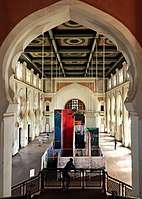 Interior view of the Senate House
Interior view of the Senate House Main Library building at Chepauk
Main Library building at Chepauk Statue of the A. L. Mudaliar near Senate House
Statue of the A. L. Mudaliar near Senate House.jpg) View of Clock Tower and Centenary building from Napier Bridge
View of Clock Tower and Centenary building from Napier Bridge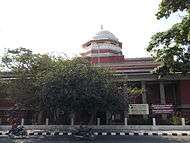 Façade of the Marina campus
Façade of the Marina campus
Schools and departments
University of Madras is organized into eighteen main schools, each of which comprises multiple departments and centres as below:[27]
| School | Departments / Research Centres / Chairs | Campus Location |
|---|---|---|
| Historical Studies |
|
Chepauk |
| Social Sciences |
|
Chepauk |
| Political and International Studies |
|
Chepauk |
| Economics |
|
Chepauk |
| Information and Communication Studies |
|
Chepauk |
| Philosophy and Religious Thought |
|
Chepauk and Marina |
| Fine and Performing Arts |
|
Chepauk |
| English and Foreign Languages |
|
Chepauk |
| Tamil and other Dravidian Languages |
|
Marina |
| Sanskrit and other Indian Languages |
|
Marina |
| Business and Management |
|
Chepauk |
| Mathematics, Statistics and Computer Science |
|
Chepauk and Guindy |
| Earth and Atmospheric Science |
|
Guindy |
| Chemical Sciences |
|
Guindy |
| Physical Sciences |
|
Guindy |
| Life Sciences |
|
Guindy |
| Basic Medical Sciences |
|
Taramani |
| Nano Science and Photonics |
|
Guindy and Taramani |
| - |
|
Chetpet |
Affiliated colleges and research institutions
The university currently has 121 affiliated colleges, with 3 approved institutions, 5 institutions for diploma and certificate courses, 15 stand alone institutions for professional education, and 53 approved research Institutions as of 2019.[28]
Notable colleges
- Loyola College
- Presidency College
- Madras Christian College
- Stella Maris College
- Women's Christian College
- Ethiraj College
- Queen Mary's College
- The New College
- Madras School of Social Work
- Madras Sanskrit College
- AM Jain College
- Guru Nanak College
- Vaishnav College
- Pachaiyappa's College
- SHASUN College
- Vaishnav College for Women
- Vivekananda College
- JBAS College for Women
- Bharathi Women's College
Research institutions
- Adyar Cancer Institute
- Central Leather Research Institute
- Central Institute of Brackish Water Aquaculture
- Defence Services Staff College
- International Institute of Tamil Studies
- Institute for Financial Management and Research
- King Institute of Preventive Medicine and Research
- Loyola Institute of Business Administration
- Madras Institute of Development Studies
- Madras School of Economics
- Madras Diabetes Research Foundation
- MS Swaminathan Research Foundation
- National Defence College
- National Institute for Research in Tuberculosis
- Zoological Survey of India
- National Institute of Technical Teachers Training and Research
- National Institute of Epidemiology
Major research grants
In 2007, the university was given a special grant of ₹100 crores by the Ministry of Human Resource Development to establish a nanotechnology research centre in commemoration of its sesqui-centenary (150th year) celebration. In 2011, University Grants Commission (UGC) selected the university for third phase of University with Potential for Excellence (UPE) scheme, under which ₹25 crores were allotted for a period of five years. Earlier, the university was selected for the inaugural phase of the scheme in 2001-02 along with five other universities in the country. The National Centre for Ultrafast Process (NCUFP) of the university has mobilized research grants to the tune ₹7 crores through several funded projects including the DST, CSIR, DRDO and UGC.[29]
| University rankings | |
|---|---|
| General – international | |
| QS (BRICS) (2018)[30] | 171–180 |
| General – India | |
| NIRF (Overall) (2020)[31] | 41 |
| NIRF (Universities) (2020)[32] | 22 |
| The Week (Universities) (2019)[33] | 11 |
| Outlook India (Universities) (2019)[34] | 32 |
| Business/Management – India | |
| Government colleges: | |
| Outlook India (2020)[35] | 24 |
The Department of Crystallography and Biophysics was upgraded as a Centre of Advanced Study (CAS) in 2007 and a grant of ₹2.53 crores was given for modernising research laboratories. The School of Life Sciences of the university received a grant of ₹5.24 crores by the Department of Biotechnology, under BUILDER (Boost to University of Interdisciplinary Life Science Departments for Education and Research) for strengthening teaching and research programmes during 2014–2019.[17] In addition, UGC has identified the Geology and Zoology departments of the university as Centres of Excellence and has allotted ₹3.25 crores each for their development.[36] In 2019, Ministry of Human Resource Development of Government of India granted ₹50 crores to the university for upgrading its research capabilities under Rashtriya Uchchatar Shiksha Abhiyan (RUSA) scheme.[37]
Rankings and reputation
Internationally, Madras University is ranked 555th for 'global research reputation' and 289th in the field of Chemistry by U.S. News & World Report for the year 2020.[38] In India, the National Institutional Ranking Framework ranked it 29th overall[39] and 18th among universities in 2018.[40] A study performed by the NISTADS on the performance of universities in India in 1998–2008 listed Madras University as No. 5 based on publication for that period.[41] The Week-Hansa Research best university survey of 2019 ranked it 11th in the multi-disciplinary university category.[42]
Notable alumni
University of Madras has a strong alumni network with its alumni taking over many prestigious positions across the world. Some of the prominent alumni include Nobel laureates C. V. Raman[43] and S. Chandrasekhar,[44] mathematicians Srinivasa Ramanujan[45] and S. R. Srinivasa Varadhan,[46] leading scientists, Raja Ramanna,[47] Rajagopala Chidambaram,[48] E. C. George Sudarshan,[49] G. N. Ramachandran,[50] V. S. Ramachandran[51] and Alladi Ramakrishnan[52] former presidents[53] Sarvepalli Radhakrishnan, V. V. Giri, Neelam Sanjeeva Reddy, R. Venkataraman and A.P.J. Abdul Kalam, politicians Chakravarthi Rajagopalachari,[54] C Subramaniam,[55] CN Annadurai[56] and V. K. Krishna Menon,[57] civil servants T. N. Seshan,[58] Benegal Rama Rau[59] and Y. Venugopal Reddy,[60] Rhodes scholars, Eric Prabhakar[61] and Tanjore R. Anantharaman,[62] pioneers Verghese Kurien,[63] Raj Reddy[64] and M. S. Swaminathan,[65] economist K. N. Raj[66] and C. Rangarajan,[67] business persons Indra Nooyi,[68] Ram Shriram[69] and Prathap C. Reddy,[70] artists and film personality M.G. Ramachandran,[71] K. C. S. Paniker[72] Gemini Ganesan[73] Mani Ratnam,[74] and Mahesh Babu,[75] sports stars Viswanathan Anand,[76] Vijay Amritraj,[77] Ramanathan Krishnan,[78] and Viswanathan Anand[79] among others.
- Physics Nobel laureate, Sir C. V. Raman
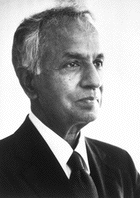 Physics Nobel laureate, Subrahmanyan Chandrasekhar
Physics Nobel laureate, Subrahmanyan Chandrasekhar Mathematician, Srinivasa Ramanujan
Mathematician, Srinivasa Ramanujan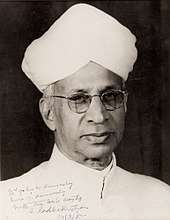 2nd President of India, Sarvepalli Radhakrishnan
2nd President of India, Sarvepalli Radhakrishnan 11th President of India, A.P.J. Abdul Kalam
11th President of India, A.P.J. Abdul Kalam- M. S. Swaminathan, Father of green revolution
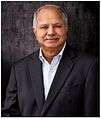 Computer scientist, Raj Reddy
Computer scientist, Raj Reddy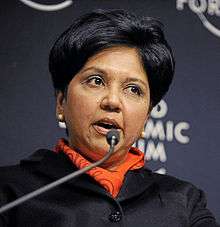 PepsiCo Chairperson, Indra Nooyi
PepsiCo Chairperson, Indra Nooyi.jpg) 1st Chief of Defence Staff, General Bipin Rawat
1st Chief of Defence Staff, General Bipin Rawat Verghese Kurien, Father of white revolution
Verghese Kurien, Father of white revolution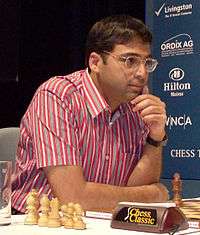 Chess grandmaster, Viswanathan Anand
Chess grandmaster, Viswanathan Anand.jpg) Telugu superstar, Mahesh Babu
Telugu superstar, Mahesh Babu- Cognitive neuroscientist, V. S. Ramachandran
References
- "University Student Enrollment Details". www.ugc.ac.in. Retrieved 10 February 2020.
- Indian Universities in the 2014 QS University Rankings: BRICS. Top Universities (24 June 2014). Retrieved on 27 September 2015.
- University of Madras. Encyclopædia Britannica.
- https://www.unom.ac.in/index.php?route=department/department/deptpage&deptid=18
- https://www.unom.ac.in/index.php?route=department/department/deptpage&deptid=51
- "Home". National Centre for Neurotoxicity Research to Assist Drug Development.
- https://www.unom.ac.in/index.php?route=department/department/deptpage&deptid=23
- https://www.unom.ac.in/index.php?route=department/department/deptpage&deptid=12
- http://riasm.unom.ac.in/about.html
- kumar, n arun (7 May 2014). "Madras University gets 'A' grade". Deccan Chronicle.
- University Grants commission ::Universities (UPE). Ugc.ac.in. Retrieved on 27 September 2015.
- "University Grants commission ::Centre with Potential for Excellence in Particular Area". www.ugc.ac.in.
- "The Vice Chancellors". University of Madras. Retrieved 17 June 2013.
- Great Britain. India Office (1819). "The India List and India Office List for 1905". p. 634. Retrieved 27 March 2018.
- Kolappan, B. (22 June 2014). "Delay, howlers in Tamil Lexicon embarrass scholars". The Hindu. Chennai. Retrieved 25 December 2014.
- htps://www.unom.ac.in/index.php?route=department/department/deptpage&deptid=48
- https://www.unom.ac.in/webportal/uploads/academics/cbcs-hand-book-2017-18.pdf
- https://www.ugc.ac.in/deb/pdf/Final_list_for_website_2014-15.pdf
- https://www.unom.ac.in/index.php?route=library/library
- https://www.currentscience.ac.in/Volumes/108/11/2110.pdf
- https://www.unom.ac.in/webportal/uploads/library/mul/mul.html
- https://www.unom.ac.in/webportal/uploads/library/mcl/aboutus.html
- "Guindy Campus Library | University of Madras". libgc.unom.ac.in.
- "Goverment Oriental Manuscripts Library and Research Centre | Department Of Archaeology". www.tnarch.gov.in.
- Parthasarathy, Anusha (7 May 2013). "A leaf from the past" – via www.thehindu.com.
- "ims library". www.indianmathsociety.org.in.
- "Schools"
- https://www.unom.ac.in/webportal/uploads/academics/cbcs-hand-book-2019-2020.pdf
- http://www.iisc.ernet.in/~currsci/dec102006/1582.pdf
- "QS BRICS University Rankings 2018". QS Quacquarelli Symonds Limited. 2017. Retrieved 2 December 2017.
- "National Institutional Ranking Framework 2020 (Overall)". National Institutional Ranking Framework. Ministry of Human Resource Development. 11 June 2020.
- "National Institutional Ranking Framework 2020 (Universities)". National Institutional Ranking Framework. Ministry of Human Resource Development. 11 June 2020.
- "The Week India University Rankings 2019". The Week. 18 May 2019. Retrieved 9 June 2020.
- "Outlook India University Rankings 2019". The Outlook. 18 July 2019. Retrieved 10 June 2020.
- "Outlook-ICARE India MBA Rankings 2020: Top Public MBA Institutions Outlook India Magazine". Retrieved 22 January 2020.
- "UGC selects Madras univ as potential centre of excellence, grants Rs 25 cr". The Times of India epaper. Chennai: The Times Group. 29 December 2011. Retrieved 30 December 2011.
- "Madras University gets ₹50 crore MHRD grant". The Hindu. Chennai. 29 December 2011. Retrieved 30 November 2019.
- https://www.usnews.com/education/best-global-universities/university-of-madras-529221
- "National Institutional Ranking Framework 2018 (Overall)". National Institutional Ranking Framework. Ministry of Human Resource Development. 2018.
- "National Institutional Ranking Framework 2018 (Universities)". National Institutional Ranking Framework. Ministry of Human Resource Development. 2018.
- "Measures of Performance of Universities in India: An Analysis of the Publication Output in Science and Technology (Study period 1998–2008)" (PDF). National Institute of Science, Technology and Development Studies. 2011.
- "Best Universities 2019: Can Indian varsities make graduates employable?". The Week.
- "After earning a master's degree in physics at Presidency College, University of Madras, in 1907, Raman became an accountant in the finance department of the Indian government." http://www.britannica.com/EBchecked/topic/490449/Sir-Chandrasekhara-Venkata-Raman
- "Chandra studied at Presidency College, University of Madras, and he wrote his first research paper", http://www-history.mcs.st-and.ac.uk/history/Biographies/Chandrasekhar.html
- "Srinivasa Ramanujan, a Mathematical Genius".
- "S.R. Srinivasa Varadhan | Indian mathematician".
- "Raja Ramanna, 79, Indian Nuclear Scientist, Dies". 26 September 2004 – via NYTimes.com.
- "INSA :: Indian Fellow Detail". www.insaindia.res.in.
- Narayanan, Anand (24 January 2013). "'All I know is how to do physics'" – via www.thehindu.com.
- https://vigyanprasar.gov.in/g-n-ramachandran/
- "The Center for Brain and Cognition - Research". cbc.ucsd.edu.
- Wikipedia, Source: (8 September 2013). "Presidency College, Chennai Alumni: Alladi Ramakrishnan, a R Narayanan, Benegal Rama Rau, C. Natesa Mudaliar, C. P. Ramaswami Iyer, C. R. Pattabhirama". General Books – via Google Books.CS1 maint: extra punctuation (link)
- http://164.100.117.97/WriteReadData/userfiles/Text%20of%20President's%20speech%20at%20University%20of%20Madras.pdf
- "The Oxford Dictionary of National Biography". Oxford Dictionary of National Biography (online ed.). Oxford University Press. 2004. doi:10.1093/ref:odnb/31579. (Subscription or UK public library membership required.)
- Dugger, Celia W. (10 November 2000). "Chidambaram Subramaniam, India's 'Green' Rebel, 90, Dies". The New York Times. Retrieved 21 March 2020.
- "Life History and Literary Works of C.N. Annadurai".
- "V K Krishna Menon; A Votary of Poorna Swaraj".
- "Welcome to MCC".
- "Contact Us – IndiaInfoline".
- "Reserve Bank of India – Database".
- https://www.deccanherald.com/content/190061/eric-prabhakar-passes-away.html
- "Brief Biographical Sketch of tra". old.iitbhu.ac.in.
- "Verghese Kurien | Biography & Facts".
- "Raj Reddy".
- "Detailed Profile - Prof. M.S. Swaminathan - Members of Parliament (Rajya Sabha) - Who's Who - Government: National Portal of India". archive.india.gov.in.
- "Nehru's planner who saw tomorrow". Business Standard India. 11 February 2010.
- "Chakravarthi Rangarajan | Ahmedabad University".
- "Indra Nooyi Biography – life, family, children, parents, school, mother, born, college, house – Newsmakers Cumulation".
- "Kavitark Ram Shriram".
- "Dr. Prathap C. Reddy – Creating Emerging Markets – Harvard Business School".
- "About MGR – the Tamilnadu Dr.M.G.R. Medical University".
- "K.C.S.Paniker Profile". www.cholamandalartistvillage.com.
- "Gemini Ganesan Biography – Gemini Ganesan Profile, Childhood & Filmography".
- "Distinguished Alumni | RKMVC".
- subramanian, anupama (6 August 2015). "Chennai has special place in my heart: Mahesh Babu". Deccan Chronicle.
- "Viswanathan Anand Chess | Indian Chess Champion". sportsmatik.com. 28 October 2016. Retrieved 21 March 2020.
- "Vijay Amritraj".
- "The Hindu : A sportsman nonpareil".
- "The chess games of Viswanathan Anand". www.chessgames.com. Retrieved 21 August 2019.